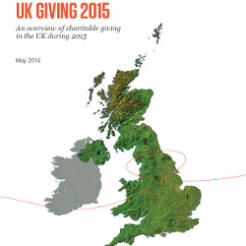Overall giving to charity fell by 5 per cent to £9.6bn in 2015, with medical research charities receiving the biggest proportion, according to the Charities Aid Foundation’s latest report.
CAF’s UK Giving 2015 report, released today, shows that overall giving fell to £9.6bn. This was down from the 2014 figure, which was £10.1bn. However, the 2014 figure initially appeared in last year’s report as £10.6bn, but was revised after CAF revisited the data.
CAF said that although these figures come with the caveat that they are “well within the margin of error”, it is still a directional decrease. The report said that these apparent decreases could be early “early indications of a decrease in charitable giving amongst individuals”, but that longer term trend data in subsequent waves will enable them to see whether this is a real trend.
The report also revealed that the cause of children and young people was the most popular in 2015 for the first time - 40 per cent of respondents who had donated to charity in the last four weeks. This was closely followed by medical research at 29 per cent. Animals and hospitals/hospices came third and fourth.
Despite this, medical research charities still received the highest proportion of total donations (16 per cent), with children and young people charities coming second with 13 per cent. Religious charities, which last year received the largest share, tied in second place.
Other key figures
- Women are more likely than men to give to animal charities (28 per cent versus 16 per cent), and children’s charities (32 per cent versus 27 per cent).
- Ten of the biggest fundraising charities raised over £250m a year for good causes.
- Most people donate to charity from time-to-time (41 per cent), with 31 per cent giving monthly, and five per cent weekly.
- Older people and women are most likely to donate to charity.
- 13 per cent had volunteered for a charity in the 12 months prior to the interview.
- 47 per cent of those who donated to charity used Gift Aid on their donation.
- Cash is still by far the most popular form of giving, with 55 per cent donating by that method. 31 per cent gave through a direct debit, and 26 per cent through a lottery or raffle ticket.
- Only two per cent donated to charity through payroll giving.
- Donations to charity peaked in May 2015 (43 per cent) coinciding with the DEC’s launch of its earthquake appeal.
John Low, chief executive of CAF, said: “The UK is a nation of fundraisers and charity shop lovers with a great tradition of being among the most generous countries in the world. In 2015, four out of every five people did something to support a good cause. This huge support is crucial to the work charities do to improve people lives both at home and across the world.
“While we should rightly be proud of this track record, many of us will be a little disappointed to see that men are still struggling to keep up with women when it comes to acts of generosity. Charities need to work harder to motivate men to back good causes and, importantly in the long-term, find new and better ways to get people involved in charitable giving at every age.
“Whatever people’s interests or circumstances, we can usually find a way to support a good cause, whether it is giving money to an appeal, baking cakes, pledging time or donating unwanted clothes. Sporting fundraisers and appeals like Movember have gone some way towards getting more men and young people giving, but it is clear that more still needs to be done.”
Methodology
The UK Giving 2015 survey collected information about charitable giving from 4,160 adults aged 16 and over in the United Kingdom. The survey ran in February, May, August and November, as a module on GfK NOP’s face-to-face omnibus study.
From May 2016 CAF will be trebling the sample size of its UK giving report, conducting 12,000 interviews per year.









